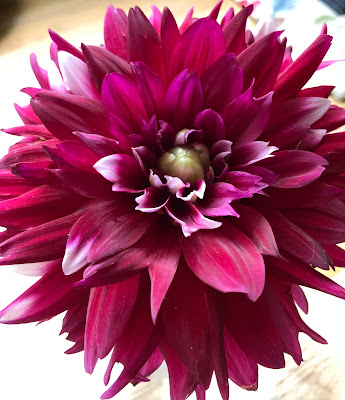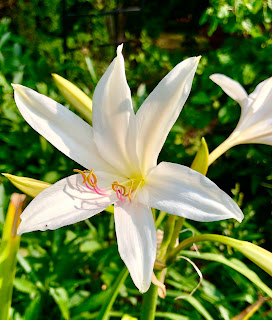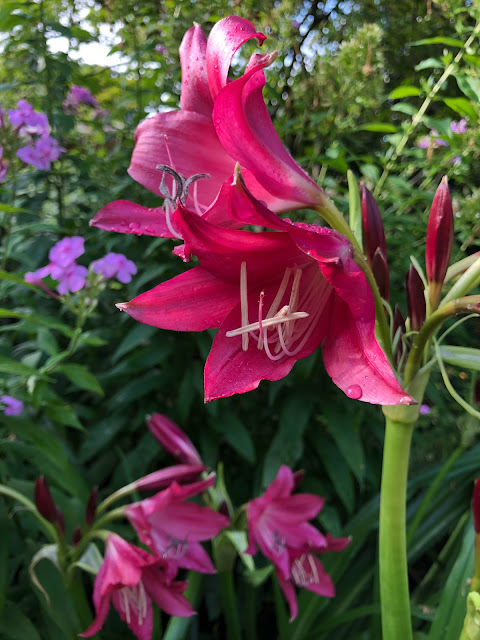SOUTHERN GARDENS IN THE DOG DAYS: THE SHOW GOES ON WITH FRAGRANCE & FLOWERS
 |
| 'Lady Luck': the name I gave to a dahlia tuber in a $5 grab bag I bought at a garden festival |
I’ve written in previous posts about the doldrums of July and August in my South Carolina garden, when I take a break (mostly) from high temps and hornets’ nests to seek the comfort of air-conditioned interiors. The deterrents to high-summer gardening are even more pronounced now that we’ve added climate change to the list: there’s no point in risking heat-stroke to rid the dahlia leaves of thrips or crush Japanese beetles with your bare hands, and for the most part, I try to be sensible as I age. However, even in late July and August I reserve the hour or two after supper for a daily sojourn in the garden, my headphones tuned to Handel’s Water Music (is there anything more cooling?) and my hands gloved against venomous caterpillars. This is my chance, on the hind end of a blazing summer day, to dead-head, water pots, pick beans, and plan for more ambitious projects when autumn weather permits. What I’m noticing this summer in my almost-one-acre plot in Traveler’s Joy* is that the numerous rainstorms we’ve had over the past few weeks have boosted growth and bloom in the beds. Despite having shrugged off this beastly season in years past, I’m having to admit that there is plenty of flowery eye-candy in my sweltering southern garden, enough to keep me lingering until a thunderstorm rolls in and I’m dodging lightning bolts as I run for the back door. Here then, in order of their magnificence, are the heat-loving keepers who make the cut.
DAHLIAS
 |
| More grab-bag dahlias |
Dahlias are the chorus girls of the late summer garden. They’re long-legged and flashy, with Big Hair to rival a pageant queen’s. They can also be temperamental: some varieties don’t stick around for more than a couple of seasons, while others, like a cactus-form pink beauty called D. ‘Campobello’ which has bloomed happily in the center of my vegetable garden for years, adapt well to their surroundings without needing to be fussed over. In our agricultural zone of 7B the question of whether or not dahlia tubers need to be lifted and over-wintered in a cellar or garage is hotly debated. Historically, gardeners have erred on the side of safety by storing them. But with the shorter, generally warmer winters we experience in modern times, I’m beginning to side with the ’leave-‘em-in-the-ground’ group. That’s because the pace of modern lives doesn’t permit a lot of time-wasting tasks in the garden, and this is one I’d like to forgo. However, since I’m addicted to British gardening programs featuring Monty Don, the sage, calm oracle of all things horticultural, I took note last autumn while viewing Gardener’s World as he advised how to lift and store dahlia tubers. I decided to imitate him to the letter when it came to a particular dahlia that I absolutely cannot afford to lose. This is one of the nameless varieties I received in a $5 grab-bag I bought a few years ago from a vendor at a Blue Ridge garden festival. All the varieties in this bag were lovely keepers when they bloomed, but this one blew my socks off when its shaggy pinkish-orange buds unfurled late in July that first year. The blossom heads were the size of sunflowers, and they stood on strong, tall stalks that required no staking.
 |
| Grab bag bulb: possibly 'Rothesay's Reveler' |
Following Mr. Don’s advice, I lifted the clump of tubers soon after the first mild frost in November, when the foliage was easily removed. I clipped straggling stems at the crown, hosed down the tubers to remove all dirt and worms, and rested the clump stem-end down on the edge of a bucket to drain. Once dried, I placed the clump in an old cardboard turkey box filled with shavings, labeled it, and set it in my half-basement away from the plant-light. I took it out in April this year, after the last frost, and planted it in its usual spot with fresh soil and granular super-phosphate, covering the tubers completely and watering them in. The jury is still out, because the stored tubers took much longer sending up growth than those which had been left in the ground (likely because spring was deliciously cool in 2023, and dahlias don’t really ‘wake up’ in the garden until the mercury stands at 70 degrees or above). So now, in the second half of July, I’m happy to finally see buds, but the stalks are on the short-ish side, and it will be August before I see flowers. If they’re beautiful plate-sized blooms, I’ll be glad I took the trouble. And if they’re ‘meh,’ I may be recycling the turkey carton.
To anyone in a warm southern climate considering growing dahlias, I recommend experimenting with different types to find out which forms perform best for you and what colors are the most pleasing. The American Dahlia Society shows 20 different flower-forms on its website, including cactus, waterlily, peony, decorative, single and ball, among others. I’ve grown yellow singles, pink cactus variations, maroon and white decoratives (one of the nameless grab-bag tubers; this one may be ‘Rothesay Reveler’) and many others, with my experience being that the charming singles, which can have dark stems and rangy habit, tend to be short-lived and susceptible to bacterial rot in my densely packed beds, while so far, my cactus variations and decoratives are proving to have staying power. No matter what form or variety you grow, you will be glad of their cheery faces in the late summer garden, when your daylilies are sporting dried sticks and your roses were long ago devoured by Japanese beetles or baked to oblivion in the heat.
 |
| The giraffe of daylilies: the late-blooming 'Autumn Minaret' |
DAYLILIES
There’s an exception to every rule, of course, and in the daylily world one giraffe-sized exception to the blooming calendar is the hemerocallis, H. ‘Autumn Minaret.’ ‘Minaret’ has made appearances in other gardening posts of mine, but I continue to write about it because the plant (or plants: I’ve divided my original clump many times over the years) is truly bullet-proof. It shrugs off diseases, insects, and hellish hot spells, and the sinuous shape of its stalks standing three to four feet above the leaves is structurally arresting. I would grow it for the stalks alone if it were suddenly to lose its ability to flower. Which I hope it never does. That’s because this is one of the last daylilies to bloom in the summer garden, with its golden, blush-throated flowers commencing to open in July when the flashier hemerocallis varieties have been played out since June. I wouldn’t be without it.
 |
| Rosa 'Perle D'or' |
ROSES
I know what you’re thinking. If there’s any rose still blooming in the southern garden after the 4th of July it’s going to be one of those mass-produced “landscape” roses that we’re so tired of seeing everywhere, like ‘Knockout’ with its endless color variations, or ‘The Fairy.’ But not all heirloom or old garden roses (OGR) are restricted to one flush of bloom in the spring. A particular shrub-rose in my garden blooms roughly from late April to December, and it’s so vigorous I have to routinely lop off large quantities of branches in order to maneuver around it. Introduced in France in 1884 (its name translates as “Golden Pearl”) this polyantha rose produces masses of creamy apricot buds that open to ruffled, fragrant flowers. Garden guides tell you it will grow 3-4’ tall at maturity, but these estimates are rubbish in southern climes, where abundant rainfall and a long growing season produce oversized plants. My 'Perle D’Or' would be six feet wide and at least eight feet tall if I let it have its way, but that’s why I’m ruthless about cutting it back. Otherwise, I would be sliced to ribbons trying to work in that corner of the garden because – did I mention this? – the thorns on Golden Pearl are lethally sharp.
The deterrent effect of these thorns may explain why so many birds choose to build nests in its branches. I was snipping off some long bud stems one morning recently and looked straight into the beady eye of a cardinal mother peeking over the rim of a nest tucked into a forking branch. I asked my husband to spread snake repellent at the base of the rose after that, and I tried hard to give the new mother some space, but there’s only so much of it to be had in a heavily cultivated garden. I hope her babies hatch.
 |
| Favorite spot for nests |
I no longer grow the antique tea, 'Mrs. B. R. Cant,' which had to be left behind in my former garden (like the Golden Pearl, it grew to be the size of a Chrysler mini-van, and simply couldn’t be relocated). But Mrs. B. R. is another long-blooming old rose that offers its fragrant, dark pink buds for bouquets through the summer and into Thanksgiving, while resisting the warm-&-wet-weather scourges of blackspot and mildew which plague newer rose introductions. This rose can be very hard to find in the trade, but it is offered online through Antique Rose Emporium.
HYDRANGEAS
I can’t imagine a southern garden without hydrangeas: they don’t often play headliners, but their pleasing shapes and rough-textured foliage perform such stolid supporting roles that I consider them to be essential shrubs.
 |
| H. arborescens 'Annabelle' |
In this climate, the hard summer-blooming H. paniculatas, like ‘Limelight,’ and cultivars of oakleaf hydrangea, like the stunning ‘Snowflake,’ or the dwarf variety, ‘Ruby Slippers’ perform better.
 |
| H. quercifolia 'Ruby Slippers' |
In May, when the first panicles appear on the oak leaf types, the blossoms are bridal white, but as the heat intensifies with summer, the panicles gradually blush pink, then darken, and by the end of the season the blossoms are a striking mauve-umber color while the foliage is purplish red.
The oakleaf species, H. quercifolia, can grow quite high and wide, so these shrubs must have space, and they also require shade, along with moist soil high in organic material. Where I grow a large screen of these hydrangeas on the northeast side of the house, I enjoy looking down on the colorful panicles from a raised deck, where the sight of all the pollinators clustered on the flowers cheers me.
 |
| Pure white panicles of H. quercifolia 'Snowflake' turn pink by July |
One blowsy-headed hydrangea that I insist on growing is H. arborescens 'Annabelle.' I control its tendency to flop by keeping a metal frame around the base that supports the woody plant's structure year-round. In May the snowy white flowers light up the shadows in my lower garden, but the heat turns them an intense chartreuse.
SUMMER PHLOX
If it’s pollinators you’re looking to attract, you can’t do much better than plant plenty of summer phlox, P. paniculata. Phlox is colorful, fragrant, and on a summer’s day the flowers will be mobbed with honeybees.
Here’s a word of caution about color: about a decade ago I planted P. paniculata ‘David,’ a mildew-resistant white cultivar. A couple of seasons on, I noticed that I was getting dark pink blooms coming out along with the white. At this point, most of my phlox patch is pink, and I finally took the time to find out why. ‘David’ is a cultivated hybrid, but if you allow the tall plants to go to seed in the autumn you will end up with plants grown from the parents, the ones crossed to make the hybrid. If you want to keep your phloxes white, you will have to either cut off the tops before they seed, or tear out all the pink ones. The second option is impossible to consider, given how attractive the color is to pollinators.
 |
| Summer phlox smells sweet |
One way I do intercede, however, is to keep the plants from growing too tall. Summer thunderstorms can flatten the stalks, and even without wind and rain, blossoms make them top-heavy and they tend to flop. For that reason, I give phlox the ‘Chelsea chop’ in early May, snipping a few inches off the growing stalks. Not only will they grow back with gusto, but at the cut, the stalk will send up additional branches, producing flowers more thickly.
SUPPORTING PLAYERS
There are so many other bloomers to enjoy now, so long as you carry a cold drink into the garden with you: just like plants, people need to stay hydrated.
 |
| Variegated shrimp plant |
I’ve been talking here about hardy perennials, or self-sowing annuals, because I tend to find bedding annuals like zinnias and petunias a lot of work for not-always-successful results, but one tender perennial I value enough to overwinter in a pot is the shrimp plant, or Justicia brandegeeana. The shrimp plant (not to be confused with the yellow shrimp or lollipop plant, Pachystachys lutea, another South American native) sports variegated green-and-white leaves and coral-colored blossoms that resemble their namesake quite closely. Some gardening websites recommend growing this plant in full sun, but as with almost everything you read online (except my blog) you should take such advice with a grain of salt. The sun in southern gardens is too strong for most except the toughest sun-lovers, like roses and irises. Everything else will need filtered light or full shade as July comes on, and this is true for my potted shrimp plant, which I usually place in the lower garden, under the sheltering branches of a giant pecan tree and a mature ‘Forest Pansy’ redbud.
The shrimp plant rubs elbows with my potted bleeding heart vine, which also overwinters under plant lights in the basement. Clerodendrum thomsoniae, a native of West Africa, is slow to warm up in the spring, but by July it's displaying white heart-shaped blossoms with crimson spots of 'blood,' a striking sight shining out of the shadows.
 |
| Bleeding heart vine |
 |
| Mexican petunia |
The hummingbirds are drawn to my patch of blue-blossomed Mexican petunia (Ruellia simplex), which has grown from a division given to me by my neighbor. Ruellia isn’t strictly a perennial in upstate South Carolina, where we get freezing temps in the winter, but in my garden the fibrous roots survive well under a thick layer of mulch and spring back every season to produce more growth as the days begin to warm up. Rubbing elbows with the ruellia is the gaudy hibiscus ‘Summer Carnival,’ with enormous pink, green and white leaves and flowers of a traffic-stopping color that is a cross between carmine and magenta. In other words, it’s no shrinking violet. It only blooms fitfully, but the leaves are so pretty I find myself handwatering the tall plant in the dog days in order to keep the foliage from drooping.
 |
| White crinum |
At the thirsty feet of the hibiscus is a passalong crinum also given to me by M., my neighbor, a beauty with white trumpets sporting pink stamens. Mirroring it in the bed directly opposite is the larger-flowered Crinum cultivar, C. ‘Ellen Bosanquet.’ The white crinum blooms earlier, starting in June, so it’s wonderful having the heady perfume of crinum blossoms scenting the garden from June to August. These strappy-leaved plants are utterly romantic and strike a tropical note; no Southern garden should be without at least one glorious crinum holding court. Crinums need the same conditions as the petunias: full sun and lots of moist, mulched soil, but in order to produce an abundance of bud stalks they must be fed throughout the growing season.
 |
| Crinum 'Ellen Bosanquet' is wonderfully fragrant |
So long as summer rainstorms keep rolling out of the west, some of the blooms in my garden that would normally be finished right now are still trucking, like the patch of fluorescent magenta bee balm, and enormous self-sowing clumps of comfrey, whose pale-blue flowers drive the bees wild. Even my compost bin is getting in the spirit of this fertile season, by producing two separate pumpkin vines from the seeds of last Halloween’s jack-o-lanterns. The pumpkins growing on the trellis I’ve placed there provide a jolt of color whenever I trek out to the bin to dump my kitchen scraps.
 |
| Compost bin pumpkin |
^^^
I keep telling myself that I’m cutting back on gardening chores during this season of intense heat and off-the-charts mosquito breeding. And yet, I always seem to end up deep in the beds come twilight, my Felco #2 shears in my right hand and a bottle of ‘Off!’ in the other. If not for me and a few busy hummingbirds, who else will acknowledge the spectacular summer flowers that are blooming beyond my back door?
Antique Rose Emporium https://antiqueroseemporium.com
American Dahlia Society https://www.dahlia.org
Southern Bulb Co. (crinums) www.southernbulbs.com
This text is solely the property of the author. No portion may be copied, edited or reprinted without the express written permission of the author. The photos used in this post are solely the property of the author and may not be copied, edited or reprinted without the express written permission of the author.


Comments
Post a Comment
Thanks for dropping by!